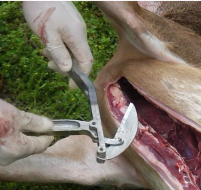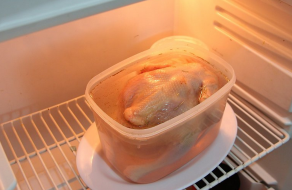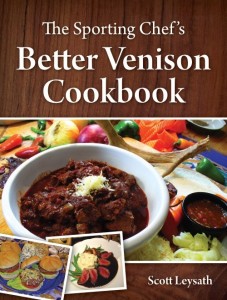How to Make Venison Taste Like Beef

Careful preparation in the field, skinning shed and kitchen will give you the best opportunity to have great tasting venison on the dinner table.
Meet the turnip-patch doe. It happened back when my middle son Ethan was just a boy. We were on a special youth hunt not far from the west bank of the Missouri River in South Dakota. The youngster was working like a trooper through some rough, cold weather in an attempt to kill his first whitetail.
One afternoon the snow finally stopped. Dark comes early in December, and soon after lunchtime we headed down through the river breaks to a stand over a food plot. The boy needed a deer, time was running out on our hunt and the whitetails were sure to be hitting the turnips planted in the little field.
Our plan worked. With about an hour of dusky light remaining, a group of five or six does approached through the cottonwoods. They bounded into the opening and started pawing away at the turnipy prizes hidden under the snow. We studied up the deer. The boy's breath came hard. I picked out a fat, medium-sized doe off to one side. Taking careful aim, Ethan squeezed off one shot and had his first whitetail on the ground.
The landowner's rules were clear: No field dressing in the field. The offal attracted coyotes, and coyotes were something the land didn't need more of. So after a quick picture session, we walked a half-mile to the vehicle, brought it back, loaded up the deer and drove a couple of miles up to the benchlands, far away from most of the whitetails, to field dress the deer.
A couple of days later, after the butchering job was over and after dry-aging some of the fresh chops in the refrigerator, we grilled a few of the choice pieces of meat. They smelled wholesome, but a little different, as they cooked. I couldn't put my finger on the essence, but when we bit in everybody's taste buds sure knew what it was: turnips!
Between eating turnips for the last month of its life and then stewing in them for a half-hour before being field dressed, we had a whitetail that offered both vegetables and meat in one serving! The venison wasn't bad at all, but I knew the 35 or so pounds of additional meat waiting in the freezer was going to need some extra attention as we consumed the whitetail.
DEALING WITH IT
Most whitetails are tender and savory to eat. From a yearling doe to a mature buck, it's the rare deer that turns out tasting bad or being tough. Yet, things happen. Like our turnip patch doe, a whitetail eating pungent food and then experiencing less-than-ideal field-dressing timing, can turn out some unexpected flavors. Then there is the reality that hunting is hunting, and eventually you or a partner is going to make a less-than- ideal shot on a deer, and that deer will have a much higher chance of tasting musky, gamey or "off."
Bottom line: As hunters it is our job to make the most of any situation, and of every deer we kill. Sometimes that involves coming up with creative ways to "take the game out of game." Fortunately, there are ways you can prevent a whitetail from becoming poorly flavored to begin with. This starts with field dressing and continues throughout the butchering process. If the meat still ends up with a gamey flavor, you have two good options: eliminate the undesirable taste or mask it.
WATCH: Check out these venison burgers from popular butcher/chef Scott Rea:
PREVENTING BAD TASTES
Taking the game out of game starts in the field and continues on the butchering table. The first concept is best portrayed by the old saying, "An ounce of prevention is worth a pound of cure." Timely and precise field dressing can prevent many flavor problems. The second concept continues that notion into the butchering process.
Here are five keys for a proper field-dressing job.
1) Field dress the animal as soon as feasible after it dies. Can you take time for a few pre-field-dressing pictures? Of course. But do that business efficiently and move on to the priority task. The sooner that animal starts cooling, the better the meat will taste.

2) Try a gut hook for performing the surgery-like incision needed to slice the animal from crotch to chest. A whitetail's stomach compartments, and its ample intestines, bulge and are easy to puncture. One alternative to lifting and pinching skin while using a regular knife upside- down is to employ a blade with a gut hook. A gut hook makes the job clean and easy, and can open up a deer like a zipper, without puncturing intestines or spilling stomach matter.
3) Carry a piece of string or a long, heavy-duty twist tie, and tie up the anus to close it off after detaching it from the rectum. This prevents fecal matter from spilling out onto any exposed meat and tainting it.
4) Learn how to remove a deer's bladder efficiently and effectively during field dressing. Care and patience are the best approaches for removing the bladder if it doesn't pull out with the rest of the stomach- cavity innards. Pinch it off at the top, slice carefully around the incoming tubes and pull it out and away from the deer.
5) Take special care when slicing around the diaphragm of any deer. Avoid puncturing the small intestines, stomach or liver, any of which can deliver undesirable substances and favors to meat.
WATCH: How to Skin and Process a Deer in 10 Minutes Without Gutting It
Once you're ready for trimming, cutting and processing:
1) Start with a clean, sterilized work surface and work to keep it that way. An easy way to assure a clean work surface is to cover it with white butcher paper and change out that paper often. If you work directly on a counter, table or boards, sterilize surfaces with a bleach solution (1 cup bleach to 1 gallon water) and rinse well.
2) Cut away bone fragments. If a bone has been hit, this means unsavory substances have reached the meat. Trim generously.
3) Trim away all bloodshot, bruised or otherwise damaged meat. Bullet fragments, slug pieces and broadhead blades all destroy meat, render it bloodshot and ruin flavor. It's best to trim more than you think you might need to, rather than less.
4) Remove all gristle, tendons, silverskin and other "extras." These materials only make meat tough and provide unwanted flavors.
5) Remove all fat. Deer fat is greasy and tallowy, and doesn't taste good like beef or pork fat does. Get rid of it.
ELIMINATING POOR FLAVORS
Let's say field dressing went well, and so did butchering. Some meat is still just going to have flavors you don't want. Imagine a late-season deer that's been feeding on cedar. Or one that ran far and had to be tracked. There are a couple of ways to eliminate poor flavors.
Brine It … Brine is a strong mixture of water and salt, immersing meat in that solution for an hour to a day, depending on the thickness and gaminess of the cut. Salt impregnates the meat, performing two services: taking out unwanted flavors and making the end flavor milder. As a bonus, human tastebuds love salt.

My mother had a simple description for this process: soaking the meat in saltwater! She would do it to tenderize and flavor a roast from an old buck. Brining is most often associated with cooking poultry but it works for red meat, too.
The salt can leach unwanted flavors. You can brine meat before cooking it in any fashion. Brining is also a common precursor to any smoking or drying process, such as when making jerky from solid strips of meat.
Brine longer for thick pieces of meat, shorter for strips. You might brine a roast for a day in the refrig- erator, jerky strips for two hours. Use an injector to make sure brine gets inside big pieces, such as roasts.
Here's a standard brine recipe to work from and experiment with:
3 cups water
1⁄2-cup kosher salt
1⁄4-cup brown sugar
*Add spices or other flavors as desired.
Smoke It … Smoking can help tenderize tough meat and get rid of poor flavors. Brining starts the process, and smoking completes it by drying the meat and leaching out other flavors. Weston Supply is a great source for smokers and supplies for game processing needs.
Grind It and Make Sausage … No deer is beyond hope! If one is going to be tough or off-flavored, another solution is grinding all of the meat and turning it into sausage products. Once again, Weston Supply has long been a trusted resource for setting up for any sausage- or brat- making process.
MASKING UNDESIRABLE FLAVORS
When unwanted flavors in venison are not overwhelming, there are two good options for making the meat taste better: marinate it and/or cook it appropriately. These practices can enhance the good flavors while de-emphasizing the poor ones.
Marinating … A whole article could be created on marinade recipes alone! That's good and bad for this reason: Your options are endless. Basically, there are a few simple rules to follow when creating any marinade:
— Use an acid (such as vinegar or lemon juice) to break down meat fibers.
— Use an oil (such as vegetable oil or olive oil) to impregnate moisture.
— Use spices (including salt or salty liquids) to create flavor.
Here is an excellent general venison marinade recipe to get you started. Use this as a base and experiment:
1⁄2-cup soy sauce
1⁄2-cup olive oil
1⁄4-cup lemon juice
1⁄4-cup Worcestershire sauce
2 Tablespoons garlic power or
crushed garlic
* Substitute balsamic vinegar for lemon juice for a variation.
* Marinate meat in refrigerator an hour to a day.
Cooking Technique … The cooking technique you use can help mask gamey flavors. You can couple any of these techniques with marinating.
— Cook long, slow and moist (such as a pot roast or in a crockpot) to "cook out" unwanted flavors.
— Stew and braise (cook long and slow in liquid) to embed better flavors into the meat.
— Avoid quick-searing and grilling with gamey meat; these techniques can capture and seal in poor flavors.
CONCLUSION
The turnip-patch doe turned out all right. The field-dressing situation added to the turnip essence already present in the meat, but a combination of the above techniques made the venison as wholesome and delicious as that of any other whitetail in our freezer that year.
But we don't hunt turnip patches much anymore!
Try This Recipe
Brining may not be for everyone, of course, so if it's not up your alley then give this great, easy slow-cooked venison roast recipe a try.
CROCK-POT VENISON ROAST
1 large venison roast
Tony Chachere's Original Creole Seasoning
1 large onion, sliced
1 package of Lipton's dry onion soup mix
2 cans cream of mushroom soup
1/2 to 1 soup can of water
Season roast liberally. Place onion in bottom of crock pot and place roast on top. Add remaining ingredients. Cook on low for 6-8 hours. Makes 6-8 servings. You can thicken the gravy after it's done and serve with rice or pasta. Egg noodles are excellent with this.
+++++

Click the photo …
Fire Up Your Kitchen!
If you're interested in more great venison recipes, you'll darn sure want to have "The Sporting Chef's Better Venison Cookbook" in your kitchen or deer camp. Wild game chef and hunter Scott Leysath has packed this 176-page book with great info, photos and more.
BUY IT HERE NOW
Source: https://www.deeranddeerhunting.com/deer-deer-hunting-pro-shop/taking-game-deer-meat
0 Response to "How to Make Venison Taste Like Beef"
Post a Comment